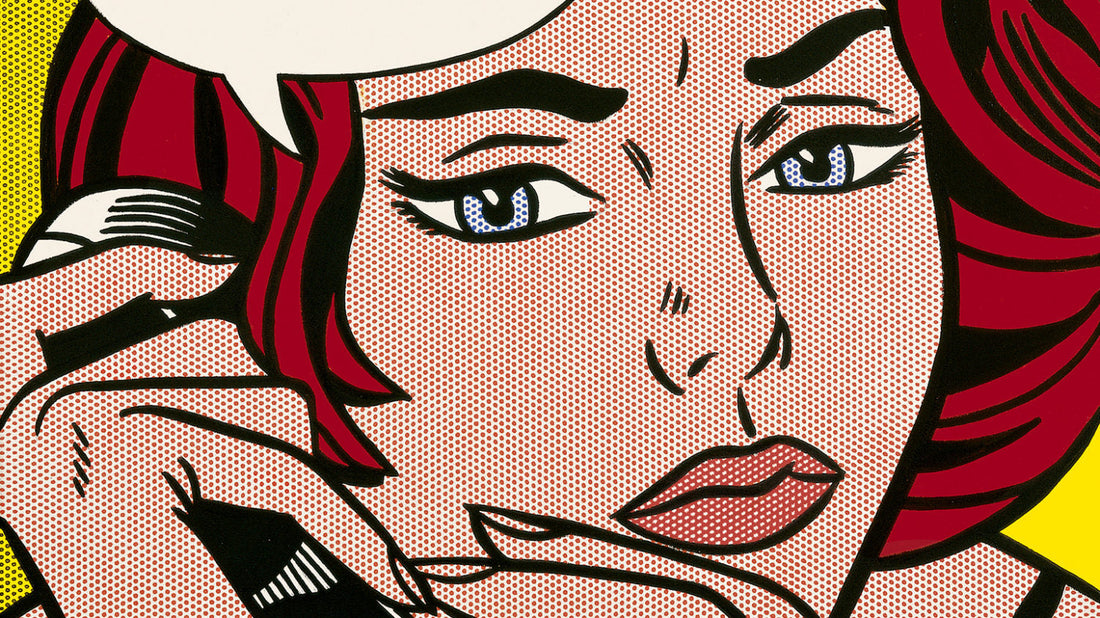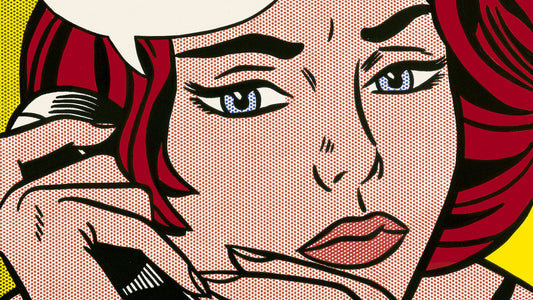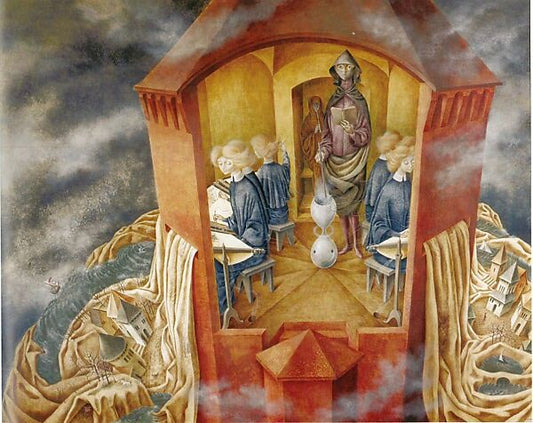Feature image: Ohhh … Alright …, 1964 via WAMU courtesy of the Estate of Roy Lichtenseuin
Pop Art emerged from the depths of a once conventional, bleak society to one filled with consumerism, activism, and expressionism. In the 1960s, the United Kingdom experienced a rebrand involving mass-produced products, advertisements, and media. Known as the Swinging Sixties, Brits thrived in a technicolor, optimistic world.
“Pop art is an art movement that emerged in the 1950s and flourished in the 1960s in America and Britain, drawing inspiration from sources in popular and commercial culture.”
Origins of Pop Art
Post-WWII was an odd yet freeing time. Historical events undoubtedly influence art, and the Pop Art movement is no exception. Hitler’s world domination ended, and the people were ready to celebrate. Aside from the war’s unfathomably tragic acts and long-lasting effects, the world started to (slightly) heal.
Pop Art founders and pioneers Andy Warhol, Richard Hamilton, and Roy Lichtenstein used well-known media to create something new to challenge traditional art- typically using intricate techniques and illustrating a scene or subject. Warhol, most famous for his portraits of Marilyn Monroe, was among the first in America to take on this new art movement. The colorful Pop Art movement radically differs from traditional art movements like Realism, Impressionism, and Expressionism. The rebellion was critical, considering what millions had just experienced in WWII. The people needed something new to focus on, and the visionaries did not disappoint.
While there are no significant differences between British Pop Art and American Pop Art, the subjects on which the artists focused varied. Marilyn Monroe, Coca-Cola, Elvis Presley, Mickey Mouse, and other American icons are among the few symbols American Pop Artists gravitated toward. Whereas British Pop Artists still used American symbols like Monroe, they also focused on the British flag, the Queen, and the Beetles.
The Founding Fathers
Andy Warhol, Jean-Michel Basquiat, and Keith Haring are names art history recognizes. While, yes, these men were pioneers of the Pop Art movement and credited for its success, other artists also contributed significantly to this bold, capitalistic movement. Jasper Johns, Robert Rauschenberg, and Richard Hamilton are the forgotten Pop artists who also shifted the movement’s impact on society. Warhol, Hockey, Basquiat, and Haring had an immense influence on Pop Art—that goes without saying. But the movement’s evolution should also be credited to uncommon artists and the Pop Artists of today.

Modern Pop Artists
Swedish Pop artist Steve Kaufman uses techniques similar to his mentor Andy Warhol; Marilyn Monroe, Coca-Cola, and Campbell’s Soup are his most used subjects for his pieces. Kaufman was Warhol’s protege for several years, adopting Warhol’s quirks and niches. Kaufman was only 19 when he began working with the iconic Pop Artist at his studio. Most of Kaufman’s catalog still feels like an extension of Warhol’s archived work.
Alex Katz, a modern pop artist, is a prime example of the evolution of pop art. He strays away from the expected and provides eccentric art. Instead of using a cluster of pop culture products and people, Katz’s focus on flat, blocked coloring that makes the piece pop reevaluates how we see and define Pop Art. His subjects aren’t globally recognized celebrities or brands but people, places, and things that hold meaning to him. His main muse? Ada Katz. He has painted hundreds of pieces of his wife. Katz’s work has highlighted the value of your loved ones over mass-produced products and over-saturated celebrities—a new take on Pop Art.
More recently, we’ve seen society, history, and art do the thing it has done for thousands of years: collaborate. Over the past 25 years, humanity has endured enough historical events to last four lifetimes. From political polarization to domestic terrorism to a global pandemic, humanity’s discourse has inspired artists.
Ketna Patel is one of many artists who have implemented these events in their artwork. Diving back into Pop Art’s roots, she takes modern pop culture icons and creates collage-like paintings. Her traditional Pop Art techniques highlight global issues rather than single-subject prints or mass-produced products like Marilyn Monroe and Coca-Cola. “W.T.F.” is a bright, chaotic, bold painting that spotlights political leaders and recent events (i.e., Covid-19) that have altered our reality.
Of course, Pop Artists of the past 20 years will use something other than popular subjects from 1950-1990, like Monroe, Elvis, and the Beetles. Artists could use modern A-list celebrities that carry the same weight as Monroe, Elvis, and the Beetles. Patel could use modern pop culture icons and symbols like Starbucks, Taylor Swift, Beyoncé, or Marvel Cinematic Universe characters. Yet, she doesn’t. And neither do many other Pop Artists. Why?
There has been a slight shift in priority and focus.
Pop Art’s New Lens
Though social media and technology have never been more accessible, Pop Art is not detectable from over-consumed products and highly saturated content. With the many life-altering events over the past 10 to 20 years, some artists have shifted their focus to subjects that address global issues like the pandemic and climate change. That’s not to say that every artist no longer highlights the materialist nature of the 2020s. We see this in Kaufman’s artwork. However, artists like Patel are paving a new way for Pop Art.
Evening dating back to the early 2000s with the 9/11 attacks, the rise of social media and consumerism, space exploration, and wars around the world, society has endured catastrophic events—enough to alter what we prioritize. Materialism and over-consumption are not going anywhere, regardless of how many pandemics and wars take place in our lifetimes. But art’s impact on people is not going anywhere either.
©ArtRKL™️ LLC 2021-2023. All rights reserved. This material may not be published, broadcast, rewritten or redistributed. ArtRKL™️ and its underscore design indicate trademarks of ArtRKL™️ LLC and its subsidiaries.












